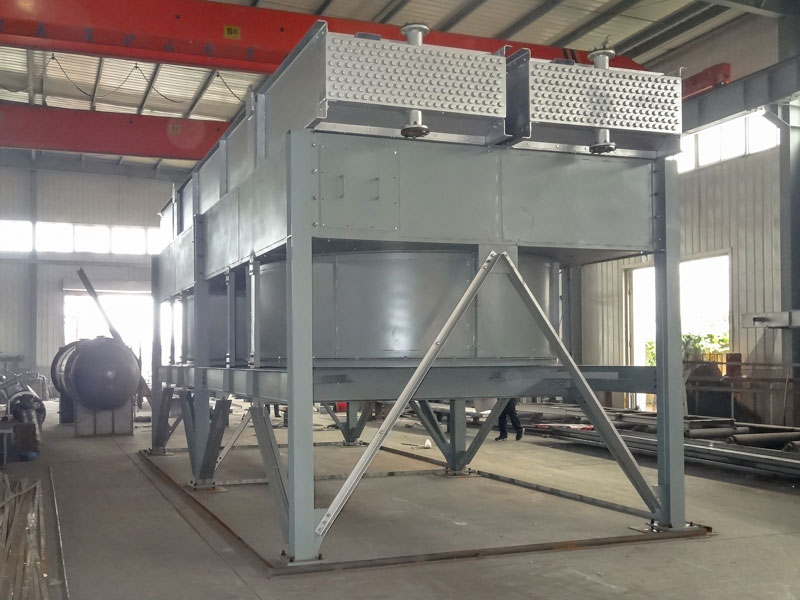How to Select the Fin type required for Specific Application in Air Cooled Heat Exchanger?
Selecting the correct fin type for a specific application in an Air-Cooled Heat Exchanger (ACHE) is a critical engineering decision that balances thermal performance, mechanical integrity, environmental factors, and cost.
It’s not a single-step process but a systematic evaluation of the operating conditions and constraints. Here is a detailed guide on how to select the appropriate fin type.
The Core Selection Philosophy
The primary goal is to maximize heat transfer while ensuring mechanical reliability over the design life, all at the lowest possible lifetime cost. The air side is almost always the limiting factor, so the fin selection is paramount.
Step-by-Step Selection Methodology
Step 1: Analyze the Process Fluid & Tube-Side Conditions
This determines the base tube material and has a major influence on the fin attachment method.
- Fluid Temperature:
- Very High Temp (>350°C / 660°F): Thermal expansion differences between the fin and tube become significant. L-fins and G-fins can loosen over time. Welded fins or Integral fins are preferred for their robust bond.
- Low to Moderate Temp: All fin types are viable. L-fins and G-fins are most common.
- Fluid Corrosivity:
- Non-Corrosive (e.g., cooling water, air): Focus shifts to air-side conditions.
- Corrosive: The tube material is often a higher alloy (e.g., Stainless Steel, CuNi, Titanium). If the air side is also corrosive, you may need expensive fins (e.g., SS). To save cost, a common approach is to use a carbon steel tube with welded aluminum fins, where the tube handles the corrosive fluid and the aluminum fins handle the corrosive air.
Step 2: Analyze the Air-Side Environment
This is the most critical step for selecting the fin material and geometry.
- Ambient Air Quality:
- Clean, Dry Air: All fin types and materials are open for selection. Aluminum is the default for its performance and cost.
- Humid / Marine / Coastal Environment: Chlorides are present. This rules out bare carbon steel and makes carbon steel tubes with aluminum fins a galvanic corrosion risk. All-aluminum extruded fin tubes or Aluminum fins welded to CS tubes are excellent choices.
- Chemical Plant Atmosphere (H2S, SO2, acids): Highly corrosive. Stainless steel fins (often welded) or all-stainless extruded fins are necessary. The higher cost is justified by a much longer service life.
- Fouling Potential:
- Dusty, Fibrous, or High-Particulate Air (e.g., near a paper mill, cement plant): Fins can clog.
- Avoid high fin density (e.g., >10 FPI). Choose a lower FPI (e.g., 7-8) to allow for easier cleaning.
- Avoid serrated fins, as they trap debris. Plain (smooth) fins are better for fouling services.
- Consider a wider fin spacing.
- Dusty, Fibrous, or High-Particulate Air (e.g., near a paper mill, cement plant): Fins can clog.
Step 3: Define Performance and Mechanical Requirements
This narrows down the fin type and geometry.
- Heat Duty and Air-Side Pressure Drop:
- High Duty, Space Constrained: You need a high surface area density. This points towards higher FPI and/or serrated fins (which turbulate the air, increasing the heat transfer coefficient).
- Low Air Pressure Drop Required (e.g., due to fan power limitations): This may require a lower FPI and plain fins, which have a lower pressure drop for the same surface area.
- Mechanical Robustness:
- High Vibration Service (e.g., near compressors, high air velocity): You need a fin with a strong bond. Embedded (G) fins or Welded fins are superior to L-fins here.
- Thermal Cycling (frequent start-ups/shutdowns): The differential expansion between fin and tube can loosen wrapped fins. Embedded (G) fins, Welded fins, or Extruded fins handle cycling much better.
Step 4: Evaluate Economic and Manufacturing Constraints
- Initial Capital Cost vs. Lifetime Cost:
- Lowest First Cost: L-Finned tubes are typically the cheapest.
- Lowest Lifetime Cost: A more expensive fin (e.g., welded) that lasts 20 years in a corrosive environment will be cheaper than replacing bundles of L-finned tubes every 5 years.
- Availability and Standardization:
- For standard services, L-finned and G-finned tubes are readily available. Exotic materials or welded combinations may have long lead times.
Quick Reference: Application-Based Selection Table
| Application | Typical Process Fluid | Air-Side Condition | Recommended Fin Type & Material | Rationale |
| Refinery/Cooling Hydrocarbons | Oil, Gas, Naphtha | Non-corrosive, Clean | L-Fin or G-Fin (Al on CS) | Cost-effective, reliable for standard service. G-fin for higher reliability. |
| Power Plant Steam Condenser | Steam / Condensate | Varies, but often clean | Plate Fin (Al) or G-Fin (Al on CS) | Plate fin for compact, high-density surface. G-fin for robust tubular design. |
| Compressor Aftercooler | Air / Gas | Same as ambient | G-Fin or L-Fin (Al on CS) | Good mechanical strength to handle vibration. |
| Chemical Process (HCl, Cl2) | Corrosive Chemicals | Often Corrosive | Welded Fins (SS on CS) or All-SS Extruded | Prevents galvanic corrosion; handles corrosive fluid and atmosphere. |
| Coastal/Marine Facility | Any | Humid, Salt-Laden | All-Aluminum Extruded or Al Welded to CS | Excellent resistance to saltwater corrosion. Eliminates galvanic pair. |
| High-Temp Exhaust Gas | Flue Gas, Exhaust | Dry, possibly dirty | Welded Fins (CS on CS or SS on CS) | Withstands high temperature without loosening. |
| Dusty Environment | Water, Oil | Dusty, Fibrous | L-Fin or G-Fin (Al on CS), Low FPI (7-8), Plain | Reduced fouling, easier cleaning. |
